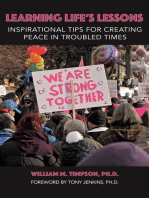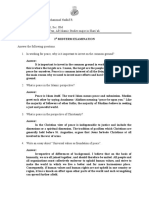Inner Peace
Inner Peace
Uploaded by
Sofia AlvaradoCopyright:
Available Formats
Inner Peace
Inner Peace
Uploaded by
Sofia AlvaradoOriginal Description:
Original Title
Copyright
Available Formats
Share this document
Did you find this document useful?
Is this content inappropriate?
Copyright:
Available Formats
Inner Peace
Inner Peace
Uploaded by
Sofia AlvaradoCopyright:
Available Formats
Inner peace: A path to global harmony
By: Sofia Valentina Alvarado Sandoval
For pursuing peace, Siddhārtha Gautama wisely proclaimed, “Peace comes from within. Do not seek it
without.” Inner peace radiates tranquility and harmony to the world around us, that’s why a positive and
peaceful mindset could change the way we navigate our lives. Throughout history, humanity has been
plagued by violence and peace has frequently slipped from our grasp because of absurdities such as
biased attitudes towards certain races or animosities rooted in social hierarchies based on caste, skin
color, religious beliefs, or gender. As an individual born in a world married to conflict, I can only imagine
what a peaceful word truly consists of. However, in this crazy fantasy of mine, I wholeheartedly believe it
is imperative for each person to discover peace within the depths of their being for a harmonious world to
come into existence.
First and foremost, it is undeniable that conflict in the world is rooted in individuals and their internal
struggles. According to Jim Dethmer, an author speaker, and coach, once we obtain the understanding
that every conflict commences and culminates within our own being, we gain the capacity to discern
between embarking upon or relinquishing such conflicts. This perspective is particularly relevant to the
pursuit of inner peace within oneself. When we reflect on our own internal conflicts, we discover that
they are often rooted in psychological factors like those influencing conflicts on a global scale. For
instance, inner struggles like unhappiness, anger, or fear are manifestations of unsatisfied needs and
underlying fears that shape our thoughts, emotions, and actions. In addition, if we come to the
understanding that everything is impermanent, it will help alleviate worries and maintain inner strength.
By acknowledging the ever-changing nature of life, people can cultivate resilience and remain centered
amidst the ups and downs of existence.
This intuition is confirmed when we consider that harmonious coexistence is achieved through education,
an often overlooked yet vital aspect of our lives. Education enables individuals to develop self-awareness,
which can provide them with opportunities for self-reflection and introspection that can help to the better
understanding of their thoughts and emotions. Jwalin Patel's article highlights educational techniques such
as Learning to Live Together (LTLT) and related concepts that promote values of empathy, compassion,
and harmony, with the aim of fostering respect for others and their cultures. A tangible example of this
positive approach can be seen in the Modesto City School District, where elementary students have
access to a Peace Path, which is a marked surface enabling them to engage in a six-step process to address
and resolve conflicts. Through open dialogue, students identify their issues, express their emotions,
consider the other party’s perspective, and collaboratively work with adult guidance to find solutions and
establish a mutually agreeable plan for moving forward in harmony. As a result of this creative initiative,
students at that school now analyze a range of alternatives and consider potential consequences, enabling
them to make more thoughtful choices when confronted with problems or conflicts.
In conclusion, the pursuit of inner peace is a crucial catalyst for a more peaceful world. By addressing the
root cause of conflict within individuals, we recognize the transformative power of finding inner peace.
Education plays a vital role in this journey, as demonstrated by initiatives like the Peace Path in the
Modesto City School District. Our inward state has a profound impact on others, with inner peace
radiating tranquility and inspiring harmony. On the contrary, agitation can transmit unease and unrest.
Therefore, by cultivating inner peace, we can create a ripple effect of calm and harmony. Let's embrace
the challenge of nurturing inner peace and becoming agents of change, creating a more understanding,
compassionate, and harmonious world for us all.
Bibliography:
Dethmer, J. (2020, June 30). All Your Conflict is with Yourself. Conscious Leadership Group.
https://conscious.is/blogs/all-conflict-is-with-yourself
Nikunj, R. B. (2020, February 27). Why can’t we live in peace?. . . The New Indian Express.
https://www.newindianexpress.com/cities/chennai/2020/feb/27/why-cant-we-live-in-
peace-2108955.html#:~:text=The%20reason%20peace%20is%20absent,their
%20economic%20or%20political%20systems
Patel, J. (2021). Learning to Live Together Harmoniously: a conceptual framework. Cambridge
Journal of Education, 1–21. https://doi.org/10.1080/0305764x.2021.1993791
You might also like
- The Mastery of Life: A Toltec Guide to Personal FreedomFrom EverandThe Mastery of Life: A Toltec Guide to Personal FreedomRating: 5 out of 5 stars5/5 (1)
- Work Organization and ErgonomicsDocument14 pagesWork Organization and Ergonomicsacarsoft100% (1)
- The Folia Melodies - R.HudsonDocument23 pagesThe Folia Melodies - R.HudsonFrancisco Berény Domingues100% (1)
- How to See Yourself As You Really AreFrom EverandHow to See Yourself As You Really AreRating: 4 out of 5 stars4/5 (97)
- Ch.5 VEDocument8 pagesCh.5 VECarl Angelo SuarezNo ratings yet
- Peace PoemDocument5 pagesPeace PoemABBYNo ratings yet
- NSTP 3rd ExamDocument2 pagesNSTP 3rd ExamMary Albios TorrefielNo ratings yet
- Agaba Emmanuel CourseworkDocument15 pagesAgaba Emmanuel CourseworkHASHIMU BWETENo ratings yet
- FoP Study Material Reference PDFDocument138 pagesFoP Study Material Reference PDFVedant ThakurNo ratings yet
- FoP Study Material Reference PDF - RemovedDocument98 pagesFoP Study Material Reference PDF - RemovedShriharsh DeshmukhNo ratings yet
- Topic 10 AbstractionDocument7 pagesTopic 10 Abstractionsukihajime2No ratings yet
- Synthesis Paper-WPS OfficeDocument12 pagesSynthesis Paper-WPS OfficeMayna BklynNo ratings yet
- Anti Camara 3Document2 pagesAnti Camara 3Jasmine AbiolNo ratings yet
- Learning Life's Lessons: Inspirational Tips for Creating Peace in Troubled TimesFrom EverandLearning Life's Lessons: Inspirational Tips for Creating Peace in Troubled TimesNo ratings yet
- IDE EssayDocument1 pageIDE EssayAlyanah SaripadaNo ratings yet
- JeshDocument6 pagesJeshJeshloed Lanzaderas100% (2)
- Navigating Inner Conflict: Finding Harmony Amidst Inner TurmoilFrom EverandNavigating Inner Conflict: Finding Harmony Amidst Inner TurmoilNo ratings yet
- Cultivating Inner Peace ModuleDocument4 pagesCultivating Inner Peace ModuleStefanie Patorio SimacasNo ratings yet
- Peace Education Reflection PaperDocument1 pagePeace Education Reflection PaperEstella GalveNo ratings yet
- GROUP 3 TOPICDocument4 pagesGROUP 3 TOPICLeigh Ann Perez BarrientosNo ratings yet
- First NotesDocument42 pagesFirst NotesLebani DubeNo ratings yet
- Embracing PeaceDocument2 pagesEmbracing PeaceJes Espago VillaramNo ratings yet
- A Commonwealth For Peace EssayDocument2 pagesA Commonwealth For Peace EssayAnuradha MukherjeeNo ratings yet
- PeaceDocument2 pagesPeaceturtle42012No ratings yet
- Prevent Conflicts in The First Place." I Totally Agree With ThisDocument2 pagesPrevent Conflicts in The First Place." I Totally Agree With ThisKristine Rose CADUTDUTNo ratings yet
- Hope Peace & Solidarity FullDocument10 pagesHope Peace & Solidarity Fullavikabansal32No ratings yet
- FPEBb6 Hadji Nabel FPE MidtermDocument5 pagesFPEBb6 Hadji Nabel FPE MidtermNadhif Radiamoda Hadji NabelNo ratings yet
- Topic 7 AbstractionDocument9 pagesTopic 7 Abstractionsukihajime2No ratings yet
- EDUM571Document25 pagesEDUM571Irreane Twenty-Third WPNo ratings yet
- Peace EssayDocument2 pagesPeace Essaykebay135No ratings yet
- Reaction Paper 1Document2 pagesReaction Paper 1Cate Arian GarciaNo ratings yet
- Final Understanding Peace and ViolenceDocument10 pagesFinal Understanding Peace and Violencenica onicaNo ratings yet
- World Peace 03082024Document2 pagesWorld Peace 03082024Naej SarabiaDuenaNo ratings yet
- The Peaceful Mindset: Essential for Personal and Global Well-beingFrom EverandThe Peaceful Mindset: Essential for Personal and Global Well-beingNo ratings yet
- PeaceDocument6 pagesPeaceIrine AridedonNo ratings yet
- emotional wellnessDocument7 pagesemotional wellnessMarcos Da SilvaNo ratings yet
- Understanding Emotions From An Indian PerspectiveDocument29 pagesUnderstanding Emotions From An Indian PerspectiveRatan SikderNo ratings yet
- Calamity: Divine Fusion For PeaceDocument9 pagesCalamity: Divine Fusion For PeaceaakshitNo ratings yet
- EssayDocument1 pageEssaybonifaciomyrna402No ratings yet
- If God wants peace for usDocument2 pagesIf God wants peace for usChady JimenezNo ratings yet
- Term Paper About PeaceDocument8 pagesTerm Paper About PeaceBuyAPaperUK100% (1)
- Gee 4 Unit IDocument7 pagesGee 4 Unit IEugene BaronaNo ratings yet
- Activity # 4 - Video ActivityDocument1 pageActivity # 4 - Video Activitybellacarmela30No ratings yet
- Coronado - Weekly Journal 8Document2 pagesCoronado - Weekly Journal 8CORONADO, Marius Miguel R.No ratings yet
- De - Mys.ti - Fy.ing MeditationDocument3 pagesDe - Mys.ti - Fy.ing MeditationHeartfulnessNo ratings yet
- Thakur MamDocument5 pagesThakur MamAnonymous CwJeBCAXpNo ratings yet
- Gse 123 PresentationDocument13 pagesGse 123 PresentationFriggaNo ratings yet
- The Reality Regarding Communist Ideologies and The Significance of Youth's Self-Enlightenment For An Established SocietyDocument4 pagesThe Reality Regarding Communist Ideologies and The Significance of Youth's Self-Enlightenment For An Established SocietyJoebhel MendevilNo ratings yet
- PeaceDocument3 pagesPeaceShaima Isik AlvarNo ratings yet
- The Path to Inner Peace: A Manual for Living in Turbulent TimesFrom EverandThe Path to Inner Peace: A Manual for Living in Turbulent TimesNo ratings yet
- Peace PsychologyDocument4 pagesPeace PsychologySoni YaduvanshiNo ratings yet
- MeditationDocument130 pagesMeditationadyro12100% (3)
- Semiotics - EnricusoDocument2 pagesSemiotics - EnricusoJed EnricusoNo ratings yet
- Education and the Significance of LifeFrom EverandEducation and the Significance of LifeRating: 4 out of 5 stars4/5 (26)
- Promoting Peaceful Minds: Education's Role in Cultivating Tolerance and UnderstandingFrom EverandPromoting Peaceful Minds: Education's Role in Cultivating Tolerance and UnderstandingNo ratings yet
- Ou 6120 Disc Mod 3Document4 pagesOu 6120 Disc Mod 3api-289445562No ratings yet
- The New Knowledge to Become a WorldDocument3 pagesThe New Knowledge to Become a WorldAwaara AgentNo ratings yet
- GMRC ReviewerDocument10 pagesGMRC ReviewerdelossantosclaireglendelNo ratings yet
- REFLECTIONDocument1 pageREFLECTIONLynn Aubrey Grace OndeNo ratings yet
- Peace and ConflictDocument4 pagesPeace and ConflictMaYour BukhariNo ratings yet
- GMRC - ReportDocument6 pagesGMRC - ReportRey Roldan RegomaNo ratings yet
- Table of Companies in India Involved in BioenergyDocument7 pagesTable of Companies in India Involved in BioenergySandra GilbertNo ratings yet
- Beer Yeast ChartDocument1 pageBeer Yeast ChartMario JammaersNo ratings yet
- Units 4-6 Test - Answer KeyDocument3 pagesUnits 4-6 Test - Answer KeyJose Manuel Rodriguez100% (2)
- Bruno MarsDocument1 pageBruno MarsMaria MarraNo ratings yet
- Branch List As On 30.11.2023Document540 pagesBranch List As On 30.11.2023Kishore KNo ratings yet
- Asian Terminals, Inc. vs. First Lepanto-TaishoDocument2 pagesAsian Terminals, Inc. vs. First Lepanto-TaishoZsazsaNo ratings yet
- Monoflo Catálogo de PresentaciónDocument10 pagesMonoflo Catálogo de PresentaciónLuis MillanNo ratings yet
- Expatriate Personnel GuideDocument10 pagesExpatriate Personnel GuidePrashant RawatNo ratings yet
- Libro Ingles 2 FotocopiadoraDocument147 pagesLibro Ingles 2 Fotocopiadora04andres_08No ratings yet
- Chap 4 Books of Prime EntryDocument29 pagesChap 4 Books of Prime EntrynabkillNo ratings yet
- Constituted Text of Vajrabodhi (T 1061)Document1 pageConstituted Text of Vajrabodhi (T 1061)Nato JanNo ratings yet
- Workplace Habits - Defender (ISFJ) Personality - 16personalitiesDocument3 pagesWorkplace Habits - Defender (ISFJ) Personality - 16personalitieskrisNo ratings yet
- Practice A PDFDocument3 pagesPractice A PDFwizard guyNo ratings yet
- Sma Sunny Home Manager Installation ManualDocument77 pagesSma Sunny Home Manager Installation ManualChrisNo ratings yet
- CQ Unit 7 - Magnetism and ElectromagnetismDocument5 pagesCQ Unit 7 - Magnetism and ElectromagnetismElisha KahemaNo ratings yet
- AVEVA Bocad Training&Guides SummaryDocument32 pagesAVEVA Bocad Training&Guides Summarychandru683No ratings yet
- Integrated Home Work Xii PCM (LPS)Document26 pagesIntegrated Home Work Xii PCM (LPS)M.K. ShuklaNo ratings yet
- OpenSAP Portal1 Week 1 ExerciseDocument19 pagesOpenSAP Portal1 Week 1 ExerciseNanda Najah MaiaNo ratings yet
- Nur Mohammad CVDocument1 pageNur Mohammad CVjacksparrow4543No ratings yet
- History of The Incas by Gamboa, Pedro Sarmiento deDocument134 pagesHistory of The Incas by Gamboa, Pedro Sarmiento deGutenberg.org100% (1)
- A Guide To Planning and Executing A TOEIC Preparation CourseDocument5 pagesA Guide To Planning and Executing A TOEIC Preparation CourseJ Yeo100% (1)
- L1 The Life of Guru NanakDocument7 pagesL1 The Life of Guru NanakMojgan SaadatNo ratings yet
- Weld Australia - Standards Map V5Document1 pageWeld Australia - Standards Map V5paullavall1968No ratings yet
- Construct 3 Manual PDFDocument1,343 pagesConstruct 3 Manual PDFjosemanuelcosta21100% (1)
- The Right Way To Play Chess (1997) by D. Brine PritchardDocument228 pagesThe Right Way To Play Chess (1997) by D. Brine Pritchardxanilob349No ratings yet
- Essay On Disposable ItemDocument6 pagesEssay On Disposable ItemShailendra Sinha0% (1)
- Gold Medal 2021 CatalogDocument124 pagesGold Medal 2021 Catalogkadosh7mxNo ratings yet
- CMC VelloreDocument14 pagesCMC VellorepranabNo ratings yet

























































































